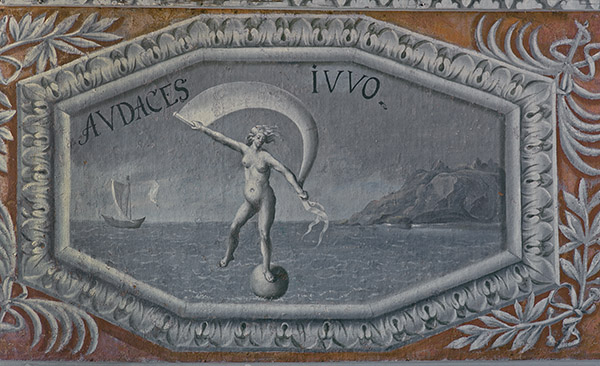Good luck comes and goes.
On people’s world view in the 1600s.
If you visit Läckö castle, you will see a mural from around 1670 depicting Fortuna, the goddess of luck, balancing on one leg on a sphere floating in the sea. In her hands, she holds a sail which is catching the wind. Above, a Latin inscription states ‟I favour the bold.”
Swedes in the 1600s explained unexpected events which brought fortune or misfortune with the intervention of Lady Luck. God also had a clear hand in the game.
Kristiina Savin is a doctoral student in the project entitled ‟Risk and history” who has written a thesis on ‟Fortuna’s Guises: Fortune, Misfortune, and Risk in Early Modern Sweden”.
The material she has studied is very broad.
‟Since I was interested in ideas that were common in Swedish society, I used source types with which many people came into contact: school textbooks, sermons, chapbook ballads, commemorative poetry, printed books of various kinds, legal proceedings, but also private documents such as letters, memoirs and travel journals.”
In the 1600s, Swedes believed that God communicated with them through fortune and misfortune. The images of a punitive yet compassionate god were interwoven.
‟One could say that God was represented as a strict but loving father – those who broke his commandments were punished, whereas the godfearing were blessed with success. In reality, of course, things were not so simple. One of the major and difficult questions people struggle with is precisely why godfearing people are subjected to misfortune and suffering. A common explanation is that God exposes his children to trials, which benefit the faithful in the long term.”
“One could say that God was represented as a strict but loving father.”
People lived by the Old Testament in which God metes out punishment in the form of natural catastrophes, war, diseases and suffering, resulting in a deterministic humility before life. God does not forget, either, and can punish people over several generations.
These divine retributions were linked to the Medieval culture of miracles.
‟It is interesting to see how the Catholic mindset was transformed during the course of the 1500s and 1600s. Medieval miracles were recorded for the purpose of documenting the powers of saints. Later on, the cult of the saints was invalidated by Martin Luther. Yet even after the Reformation, stories of marvellous events were disseminated in various contexts, both orally and in writing. One example is that of miraculous salvation: small children who fall from windows, but survive unharmed, or prisoners who manage to escape from jail against all odds. Sometimes, such events were explained by the intervention of the angels, and sometimes only described as God’s miracles.”

In Kristiina Savin’s thesis, Fortuna is also a central figure. The goddess Fortuna was an important element that was integral to scholarly discourse at the time. Already in school, children learnt about what fortuna was and how to speak and write about it. The common definition, derived from Aristoteles, was that fortuna is what happens to human beings without them having planned or intended it. The fortune which lies beyond our power, or that we are not wise enough to understand.
Today’s concept of luck does not have the same meaning as the early modern interpretation of the word. Then, luck was interwoven with religion, philosophy and politics.
‟As luck (fortuna) referred to everything unintended that happened to people, one could wonder whether there was some higher plan behind these events. Within the Lutheran religion, such accidental occurrences were seen as an opening onto the divine – priests claimed that everything, even the seemingly accidental, was determined by God. Not a single sparrow falls to the ground without his will. Within politics, people needed to explain the successes and setbacks of the Swedish state. In the 1600s, it was also natural to consider politics in a religious framework. God gave the Swedes successes and setbacks, fortune and misfortune, everything that was summarised in the concept of fortuna.”
But how did people in the 1600s view the difference between luck and chance?
‟Those who had been to school had learnt to distinguish between luck (fortuna) and chance (casus). We can speak of luck in situations where there is human agency with intent and plans, but which are affected by external circumstances. Chance is where there were no particular intentions and things merely happen. These distinctions were not always taken into account. Only learned people were aware of them, and they were not well known among the wider population.”
At the same time, Swedes in the 1600s did not feel powerless, but could strive and work towards the position to which they aspired. This complex worldview can be found in scientific sources from the time, which explain that the most important antidotes to undesired events are knowledge and good planning. Every individual crafts his own fortune, according to an old Roman proverb, which was often quoted.
‟It is important to emphasise that the way in which luck was considered also depended a lot on the situation. In writing consolatory words, for example when comforting the relatives of an accident victim, it would not be appropriate to say that we all craft our own fortunes. In such contexts, it was common instead to highlight human vulnerability – one would say that luck was blind and that God works in mysterious ways”, says Kristiina Savin.
Around the 1700s, most Swedes lived in an oral environment where knowledge and feelings were communicated verbally. The most important oral channel was the pulpit, and rhetoric influenced written documents, which were often formulated to be read aloud to an audience.
‟Oral rhetoric was more emotionally charged and full of dramatic effect, strong images and stories, but also proverbs and sound effects such as rhythm and rhyme”, says Kristiina Savin.
Suffering was seen as a natural part of life at the time. So how did people find consolation, both for the soul and for the body? For bodily problems, there were physicians. Spiritual troubles could also be alleviated to some degree using food and medicines, but the most important sources of comfort were ideas taken from religion, philosophy and rhetoric.
‟So, for example, one of the first rhetoric handbooks written in Sweden contained an exposition several pages long on arguments to soothe sorrow. The vast majority found support in religion and popular culture which communicated a worldview in which luck constantly fluctuated and misfortunes were seen as a natural part of life – good fortune comes and goes.”
Kristiina Savin thinks we could learn a lot from the people of the 1600s and from their view of life. We cannot be invariably happy and should have a more balanced view of the relationship between success and setback. Luck fluctuates, and setbacks should not be considered as a deviation from the normal course of life, but rather as a natural part of it.
What would a person from the 1600s have thought of our lives and our explanatory models, which are usually scientific, if they were to turn up in Sweden in 2017?
‟A person from the 1600s would probably marvel that so many of us are so unhappy despite being so fortunate today. And that we have become completely fixated on success and lack existential preparedness for unexpected setbacks, despite having access to more knowledge than ever before. Scientific explanations often fall short in such situations. Fortune was about precisely that which cannot be dealt with using science – losing your job, failed relationships, rebellious children, or quite simply not achieving what one would have liked. Even though a person who is diagnosed with cancer today can soberly consider the disease against the background of probability based on statistics, still the question remains: why me?”
Text: Bodil Malmström









